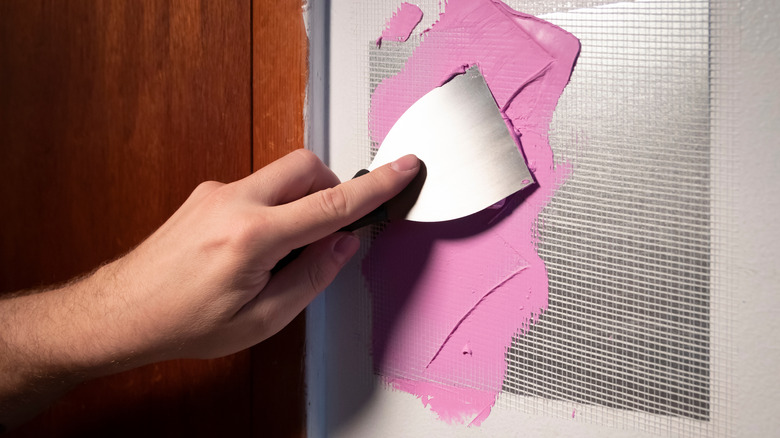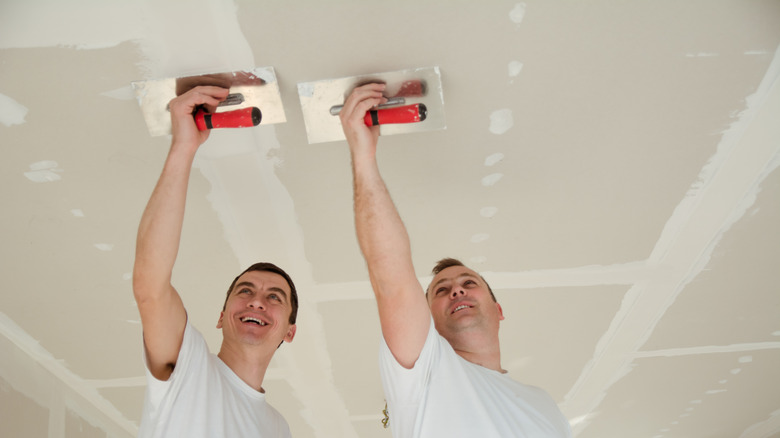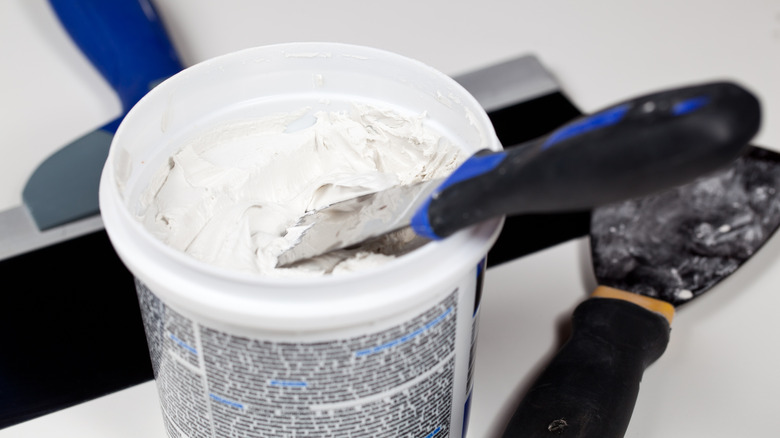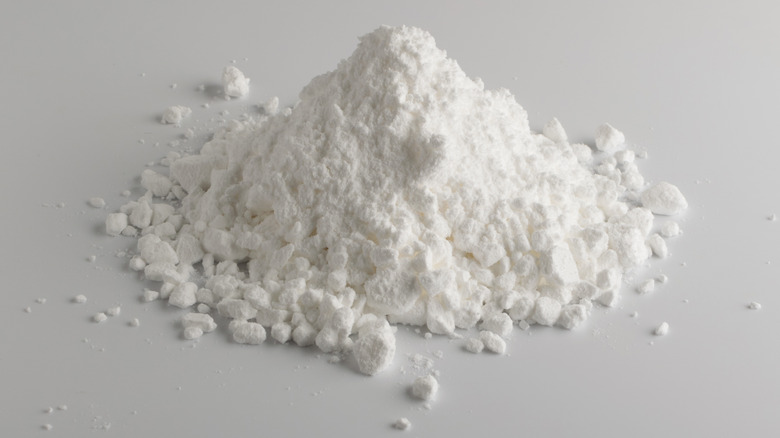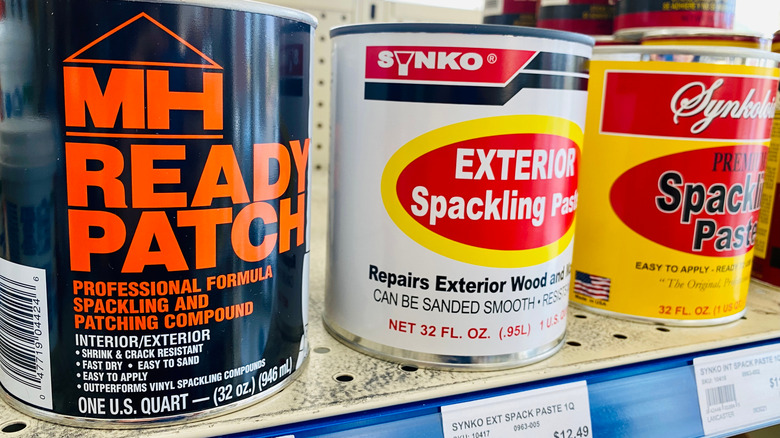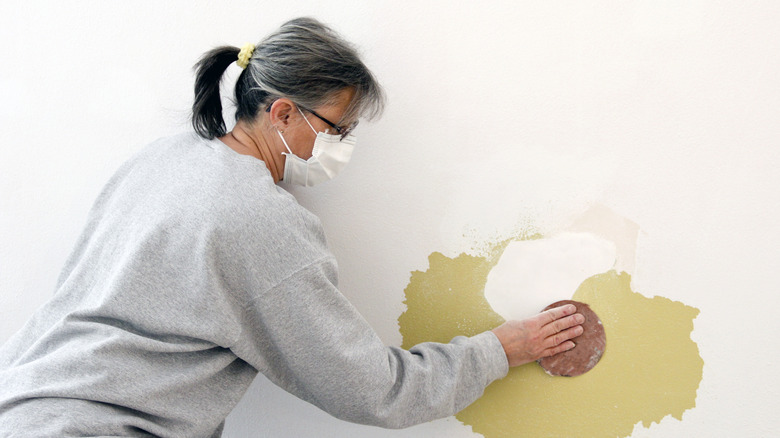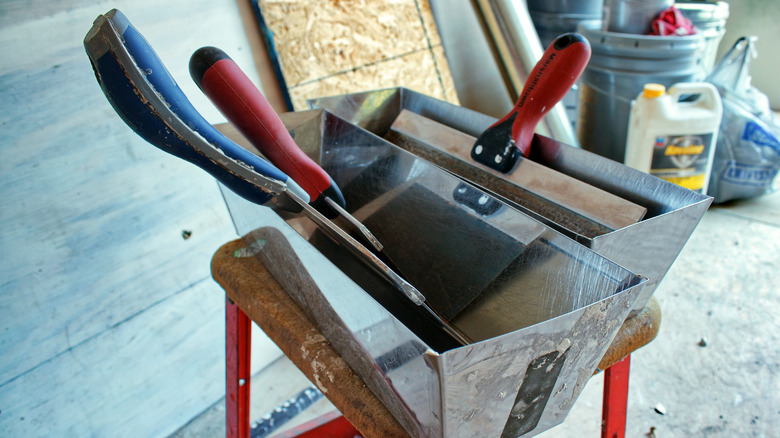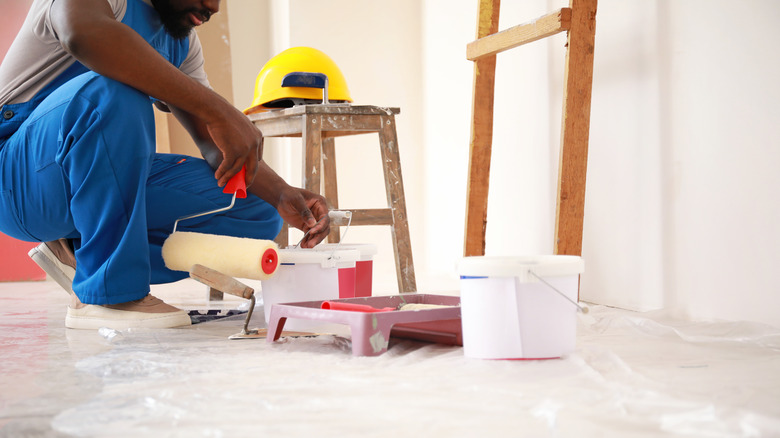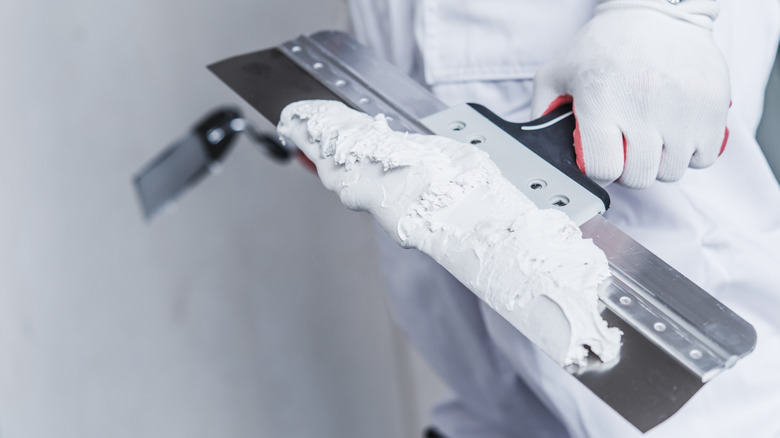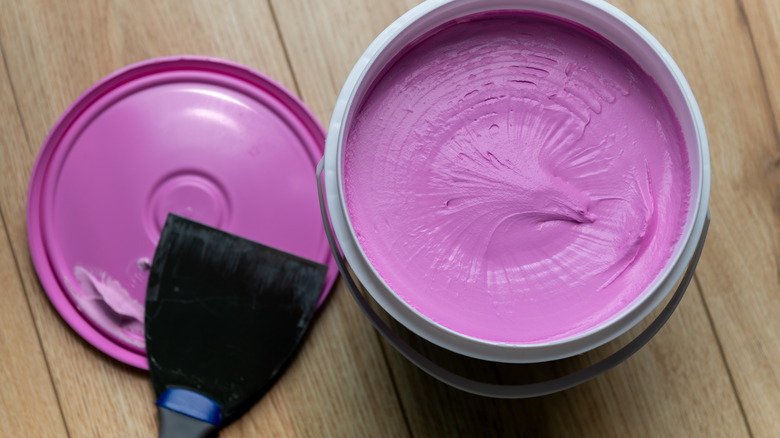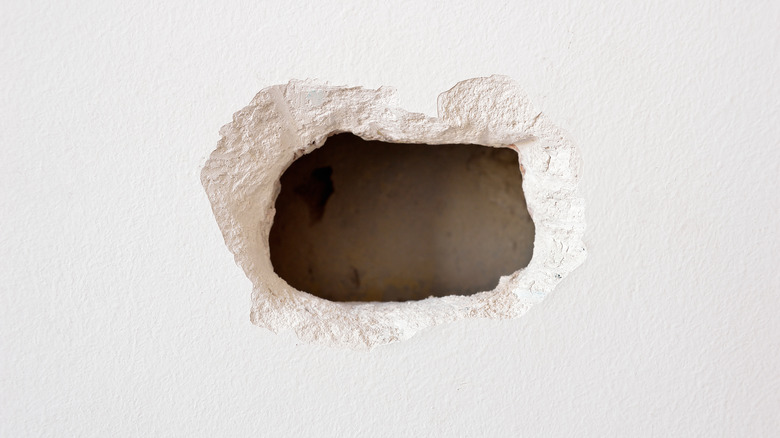Joint Compound Vs. Spackle: What's The Difference?
We may receive a commission on purchases made from links.
Joint compound and spackling paste are two products that basically perform the same job, so it's understandable that homeowners and DIYers get confused about the differences between the two. The products can be very similar, but at other times they are completely different in their chemical makeup, purpose, and ease of use.
While both are meant for fixing imperfections in walls, joint compound, also called "drywall mud" or just "mud", is usually used on new, unfinished walls to conceal joints, seaming tape, and screws. It is sometimes also used to make large repairs to previously finished walls. Spackle, on the other hand, is almost always used on finished walls to fix the dings and nail holes of daily life. Joint compound can perform spackle's job reasonably well, but you wouldn't want to use spackle to conceal joint tape when hanging drywall. And even if you did want to, you probably couldn't, since joint compound is engineered to have the consistency and properties you'd need for smoothing large quantities over a fairly long period of time. Spackle is specifically designed to fill small holes and dry quickly (via Lawrence Journal-World).
Types of joint compound
There are a number of ways of looking at the differences in various joint compound products. It might be most useful to think of them as premixed versus powder. There are also drying-type joint compounds versus setting-type joint compounds. However, the most useful way might be to break the products down by purpose and their special characteristics like all-purpose, topping, taping, and quick-setting joint compounds.
All-purpose compounds can be used for a wide variety of uses. Topping compound is for final the final coat or coats of the drywall finishing process. It is often applied over taping compound, which is used to hide drywall joint tape and to set the seam between taped boards. Quick-setting joint compound has similar properties as spackle but is still quite a bit slower to use.
Manufacturers also sell their joint compound by weight. For example, Sheetrock brand joint compound is available in Conventional, Midweight, Lightweight, and Ultra-lightweight varieties. You can also consider whether a joint compound is a drying type or a setting type. Drying joint compound hardens vis evaporation while setting joint compound hardens via a chemical reaction when you add water to it. Setting-type joint compound is formulated to cure faster and with less shrinkage.
Types of spackle
Spackle is really a purpose rather than a particular class of compounds. Indoor spackling pastes include lightweight and standard or all-purpose spackle. These are gypsum-based like joint compound and are basically meant for small drywall repairs (via HomeServe). Spackle containing vinyl, acrylic, or epoxy can be used both indoors or outdoors and are formulated for more specific or broader uses. Vinyl spackle, for example, is useful for filling deeper holes. Acrylic can be used on a lot of substrates, including brick and wood. And epoxy is a super-durable oil-based product useful for wood repairs.
When you hear the word "spackle" it's likely the gypsum versions being discussed. The other types are chemically very different from lightweight and all-purpose spackle and have completely different traits. Epoxy spackle, for example, is a two-component product that includes a resin and a hardener. It's often used for repairs to outdoor wood where durability and waterproofness are key. Its makeup, applications, and traits are very different from standard spackle.
What is this stuff made of, anyway?
Many spackling pastes and most joint compounds made for drywall are made up primarily of gypsum, a soft-mined mineral (calcium sulfate dihydrate) used extensively in the construction industry. You'll find gypsum in drywall, plaster, patching compounds like joint compound, and portland cement (via Bit Service). Spackle also generally contains a fine aggregate, often sodium silicate, and a binder. This type of aggregate helps spackle dry faster, reduces shrinkage, and enhances smoothness. Some spackle includes chemicals that make it suitable for a specific type of use. Vinyl, for example, is often found in lightweight spackling pastes (via the Lawrence Journal-World).
The main body of most joint compounds is usually gypsum and limestone, along with such minerals as quartz, talc, mica, and perlite. All-purpose joint compound is also likely to contain clay. Beyond clay, things tend to get a bit more unpronounceable including binders like polyvinyl acetate and its plasticizer, polyoxyethylenearyl. Formulas can also contain thickeners such as hydroxyethyl cellulose, methylcellulose, and gum arabic (via My Chemical-Free House ).
What are the differences in cost?
Comparing the costs of these two items can be a challenge because of their differing uses. Joint compound is used in large quantities by builders so it can be a lower cost and can be purchased in large quantities. Spackle tends to be used in very small quantities by homeowners so you can purchase every size from a tiny jar to a large container.
Joint compound is typically sold in 1-quart containers or larger (via The Home Depot). The average price of joint compound is $0.17 per ounce. The price points range from $0.03 per ounce for a 3.5-gallon bucket of ready-mix to $0.68 an ounce for a quart of DRICORE PatchPro.
On the other hand, spackling paste is commonly available in containers as small as 5.5 ounces. It's also more expensive with an average per-ounce cost of $0.56. The most expensive is a 5.5-ounce tube of DAP DryDex at $1.18 per ounce, while the least expensive was for a gallon of DAP Phenopatch at $0.18 per ounce.
Obviously, for both spackle and joint compound, it pays to buy in quantity. But even though spackle is sold in small quantities, it's unusual to use it all at once. So don't buy more than you think you'll need, plus a little buffer. You also might be using drywall mud over a long span of time throughout the finishing project. Be sure to keep either material in an airtight container when they're not in use to avoid them drying out.
Is spackle safer than joint compound?
Both spackling and drywall compound have safety risks, and they are nearly identical. The conventional wisdom is that the most immediate danger of modern joint compound applies mostly to tradesmen who are exposed to it, and its dust, nearly every day. However, according to the American Association for the Advancement of Science, research in the seventies showed that some risks can extend to homeowners. And if your home was built before 1980, there's a good chance that they contain asbestos, since both drywall and joint compound manufactured prior to the '80s were likely to, according to DoItYourself.
The asbestos problem has been regulated out of existence, but others remain. Perhaps the most significant today is the silica dust that is released when spackle and joint compound are sanded, meaning the risk is likely greater for installers than for homeowners (via International EnviroGuard). Using thin coats that require less sanding when working joint compound and spackle can reduce dust. It's important to wear face masks, head coverings, and other protective gear as well.
These substances can also contain VOCs that can stick around in the air you breathe gas even after the spackling or med dries (via Environmental Working Group). Fortunately, there are products that are widely available that feature low or even no detectable VOCs. Look for Greenguard-certified formulas that are both better for your breathing and still effective for your project.
To the features... and beyond!
As a consumer product focused on drying time and ease of use, these are the features typically promoted by spackle manufacturers. The most common feature of spackle is a fast-drying formulation, which has become so common it's almost a necessary feature. A little less common is a dry-time indicator that lets you know when the spackle is ready for sanding. This is a key benefit found in DAP's DryDex product, which turns from pink to white as it dries. Some spackling pastes come in colors designed either to match paint closely enough or to make painting over with matched paint a bit easier, such as Soto's Premium Lightweight Spackle (via Amazon). Patents have also been filed for spackling pastes that would be available in colors designed to contrast with the wall color so the areas that need sanding and painting don't get missed (via Google Patents).
Joint compounds, on the other hand, typically feature incremental improvements in performance over dramatic innovations. Features like "reduced shrinkage" and "improved open time" appeal to builders where these marginal improvements add up over the course of a building season. Many of the top joint compounds on the Lowes website have similar bulleted features in common. Reduced dust and improved slip were key features in 8 of the 14 formulas. Nearly half touted that they were pre-mixed and quick-setting. And one even promised to not clog sandpaper to make the finishing process more efficient.
How easy is each to DIY?
It's fairly to say that applying joint compound is meant for those with professional skills while spackling paste is purpose-built to be usable by anyone. Some spackling pastes take the ease of application to an extreme by building applicators into their packaging, such as DAP's Fast'N Final Lightweight Spackling. But in general, it involves pushing some into the hole to be filled, then smoothing with the edge of a putty knife. Simply let it dry, sand it, and reapply layers as necessary,
Using joint compound involves a lot more complexity. It can be used for seaming two pieces of drywall, taping an inside or outside corner, or filling a large gap. There are also some more tools involved. If you were to fully outfit yourself for installing drywall, you might have a collection of knives in various sizes, including 8 to 14-inch options. You'll need a mud pan that can accommodate a knife of that size, a drywall hawk, a drill attachment for mixing joint compound, and a pole sander for getting to higher spots when sanding. Knowing how to use any one of these tools isn't difficult, and drywall mudding is considered a beginner project. However, the smoothness of the end result is directly related to the mudding and finishing skills involved. Watching instructional videos is useful, and If you can find a way to practice, that would be very effective as well.
Pros and cons of joint compound
There's always a gray area to be found, but generally speaking the pros and cons of joint compound and spackling paste align with their purposes. For example, joint compound is engineered for large-scale use. It is easier to apply smoothly over a large area and easier to sand. As a rule, it has a short open time, meaning that you're going to want to move fast, using material efficiently in a short period of time. There are different formulations for different purposes. Filling large holes, for example, will require a heavier compound than applying a thin topcoat. Joint compound also tends to shrink more than spackle, and it's often a good idea to apply joint compound in multiple layers, to manage dry time and shrinkage better.
Joint compound also benefits from the use of professional tools. You might get away with a broad putty knife for some uses, but a proper tape knife, pole sander, and even more specialized tools are required for most projects. You likely don't need to spend thousands of dollars on drywall compound pumps, corner finishers, drywall tapers, and flat boxes like high-volume drywall pros will (via Level5 Tools). However, you certainly want to be prepared with the proper tools to make your finished walls look as good as possible. If drywall finishing is something you don't have a lot of practice at, compounding the problem with poor tools isn't the best approach.
Pros and cons of spackle
While both are finishing products, spackle is generally meant for minor repairs, as evidenced by the things at which it excels. The key thing about spackling paste is that it dries fast, usually within a few hours. DAP suggests giving its Fast Dry Premium Spackling 15 minutes before painting or applying a second coat. The instructions also note that large holes should be left to dry overnight. This faster drying time is key for homeowners, who tend to want to make quick repairs and efficiently prepare walls for painting.
Spackle also tends to shrink very little. This is particularly important for single-layer applications. Spackling a wall hardly requires anything in the way of specialized tools to use effectively. You can successfully complete a basic spackling job with just a simple putty knife and a sanding block or paper. You can also use any household item with a flat edge if you don't have a putty knife. A ruler or old credit card can be great makeshift tools for spreading spackle.
When to choose spackle over joint compound
If you're rearranging the wall art in your living room or repainting a bath, spackle is made just for you. Finishing a basement or building a new house, on the other hand, clearly calls for joint compound instead. These uses for both are fairly clear, but what about the gray areas?
For the DIYer, the dry times associated with joint compound mean that you're usually better off using spackling paste when you can. These extensive dry times required are built into professionals' construction timelines. Homeowners, however, don't want to set up all of the joint compound supplies to apply a coat and clean up, only to repeat the steps for another coat the next day.
So, you can use spackle to fill nail holes or small dings that are less than 1 inch wide in ¼-inch layers. You can also use vinyl spackle to repair larger wall holes. Holes as deep as ¾ inch can be filled with vinyl spackle, but beyond that, you might need to consider joint compound (via Lawrence Journal-World). You can also use acrylic formulas for small patches to materials like stone, brick, or wood and epoxy spackle for extra-durable outdoor fixes. However, spackle might not work well on corner beads, joint tape, or the like. These are drywall installation applications and might require joint compound.
